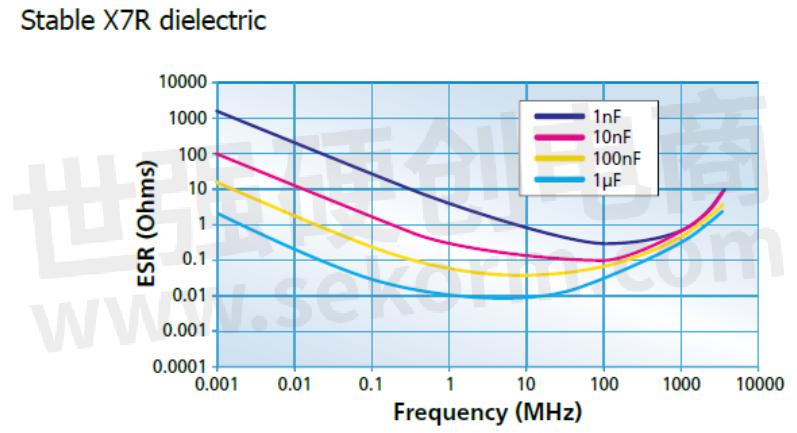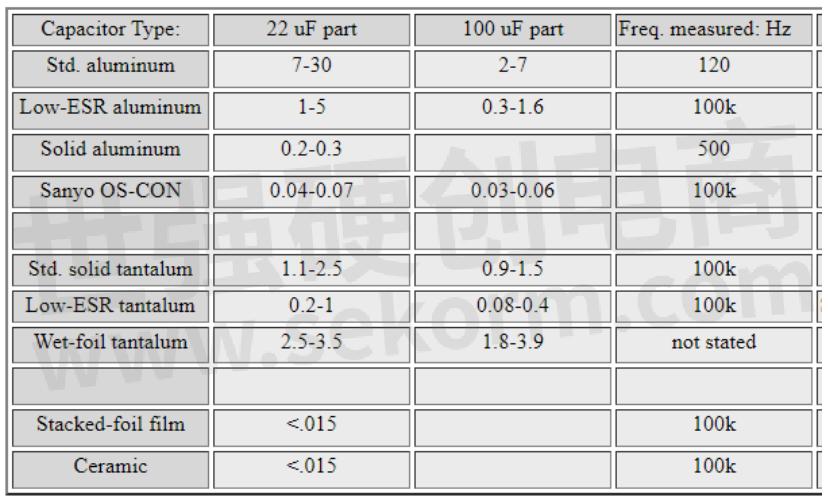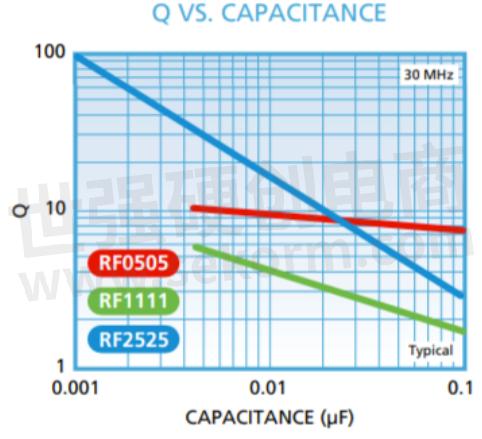Understanding the Impact of ESR on Ceramic Capacitor Selection

In an ideal world, capacitors could be designed in a way where they would exhibit no resistance. However, this is physically impossible to achieve as there will always be some type of internal resistance in a capacitor that appears in series with the capacitance of the device. Known as equivalent series resistance (ESR), the level of this resistance will vary across capacitors depending on a variety of factors including the dielectric materials used, frequency of the application, leakage, and quality and reliability of the capacitor. The two graphs in Figure 1 show an example of how ESR can change as frequency increases across various capacitances on two different classes of ceramic dielectrics.


Figure 1. The top graph shows the ESR vs frequency for capacitors using a Class I dielectric while the bottom graph represents a Class II dielectric (both from Knowles Precision Devices).
The value of ESR may be very small in some instances and is negligible for some simple designs or low-frequency applications. However, for some high-power or high-frequency applications, accounting for the ESR value in the overall impedance calculations can be crucial for maintaining operational efficiency or preventing potential failures. Let’s look at how to account for ESR for these types of applications.
Know Your Self-Resonant Frequency
First, to ensure your capacitor is operating at the point where resistance is minimal, it is important to understand the self-resonant frequency (SRF) of your circuit. The SRF is the point where the capacitor will exhibit the least amount of impedance since at this point ESR is the only factor contributing to the total loss of the capacitor. At low frequencies, impedance is dominated by dielectric losses due to delay of polarization. As frequency increases above the SRF, parasitic inductance begins to dominate the behavior of the circuit, which can cause the capacitor to overheat and potentially lead to failure. Since ESR is dependent on the frequency of the application, the SRF is impacted by the operating frequency as shown in Figure 2.

Figure 2. A representation of how impedance changes as operational frequency increases.
Using Low-Loss, High Q MLCCs to Minimize ESR for High-Frequency Circuits
In general, aluminum and tantalum capacitors exhibit a higher ESR than ceramic capacitors of the same capacitance and voltage rating (Table 1).

Table 1. This table shows “typical” ESR values for capacitors using different dielectrics.
Thus, multi-layer ceramic capacitors (MLCCs) are usually the best option for high-frequency or high-power applications. By using low ESR MLCCs in these applications, capacitor losses can be minimized, while the efficiency and stability of the power supply are increased, and the output ripple voltage is decreased.
At Knowles Precision Devices, we understand the impact ESR can have on these high-power or high-frequency circuits where Q is critical. We also know that there is not just one ultra-low ESR capacitor that can work for everyone since ESR changes depending on the frequency your device is operating at. Thus, we make a line of Class II ceramic dielectric (BX or X7R dependent on chip size) that offers high volumetric efficiency with negligible piezoelectric effects. We specifically designed this series to operate reliably in rugged environments such as those present in high-power broadband coupling and switching power supplies. Below are two charts showing the ESR vs. capacitance and Q vs. capacitance of three of these capacitors built on different dielectric materials (Figure 3).


Figure 3. Knowles Precision Devices makes a line of capacitors that can function reliably while minimizing ESR.
Overall, a capacitor with low ESR dissipates less heat and can prevent overheating of the MLCC which could potentially lead to capacitor failure. Therefore, if you’re making a circuit that requires high power or needs to operate at a high frequency where any amount of additional resistance could negatively impact your circuit, you need to be aware that ESR is a factor that must be considered for your application to function reliably.
- +1 Like
- Add to Favorites
Recommend
- Nippon Chemi-Con Added NTJ Series Metal Cap Type Multilayer Ceramic Capacitors with 50V Rated Voltage and Capacitance Expansion
- Nippon Chemi-Con Added NTS/NTF/NTD Series High Withstand Voltage Multilayer Ceramic Capacitors witih 500V Rated Voltage and High Capacitance
- The DC Bias Phenomenon of Multilayer Ceramic Capacitors (MLCCs) Explained
- Nippon Chemi-Con Expanded Product Line of Multilayer Ceramic Capacitors Improving Capacitance Density and with Higher Voltage Resistance
- Flexibility of Multilayer Ceramic Capacitors: Guaranteed 5mm of bend on AEC-Q200 Certified Components
- Microwave High-Q Chip Multilayer Ceramic Capacitors for 5G Communications Won the Science and Technology Progress Award of the Electronic Information Industry Association
- Nippon Chemi-Con Updated KVJ Series Metal Cap Type Multilayer Ceramic Capacitors with High-Temperature Reliability
- Knowles to Participate in Upcoming Baird Conference in New York on June 4, 2024
This document is provided by Sekorm Platform for VIP exclusive service. The copyright is owned by Sekorm. Without authorization, any medias, websites or individual are not allowed to reprint. When authorizing the reprint, the link of www.sekorm.com must be indicated.





























































































































































































































































































































































































































































































































































































































































































































































































































































































